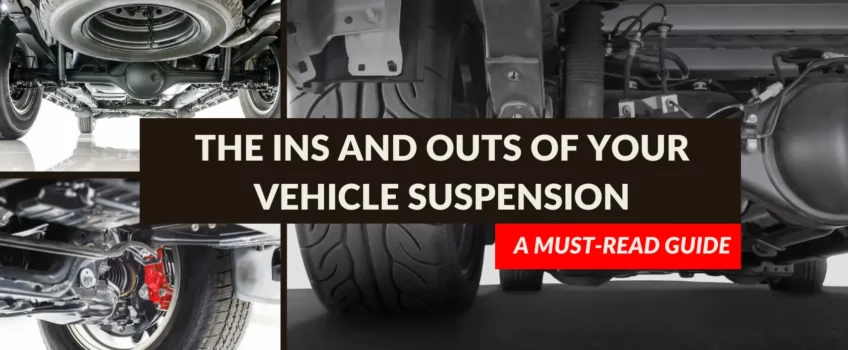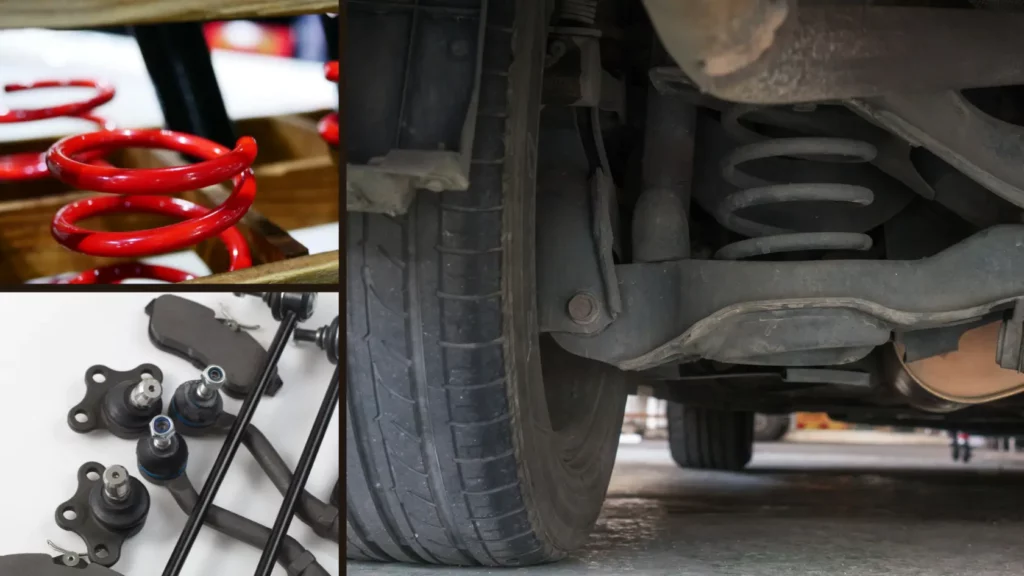
Journey Through Your Car’s Underbelly: A Deep Dive into Vehicle Suspension
Vehicle suspension refers to the system of springs, shock absorbers, and linkages that connects a vehicle to its wheels and allows relative motion between the two. But do you know why it’s so important? In this guide, we take a closer look at what your vehicle suspension does, how it works and why it’s important. There are also a few important FAQs you don’t want to overlook!
Why is Vehicle Suspension Important?
A well-functioning suspension system ensures a smooth ride, maintains wheel alignment, and facilitates precise steering. It also helps in reducing wear on tyres, providing you with a safe and comfortable driving experience.
Types of Vehicle Suspension Systems
Conventional Suspension System
The conventional or dependent suspension system, often found in older vehicles, connects the front and rear wheels on each side of the vehicle. As a result, movement on one wheel influences the opposite wheel.
Strut Suspension System
The strut or MacPherson strut suspension system, most common in modern cars, combines the shock absorber and coil spring into one unit. It’s a simple and cost-effective system, which also reduces vehicle weight.
Multi-link Suspension System
The multi-link suspension system, typically used in luxury and sport cars, allows for more independent movement of the wheels. This leads to better handling and ride quality, although it’s more complex and expensive to maintain.
Air Suspension System
An air suspension system uses air springs instead of traditional coil springs. The air springs provide a smooth ride and allow for adjustable ride height, often preferred for luxury and heavy load vehicles.
Key Components of a Vehicle Suspension System
Springs
These components absorb and store energy, helping to cushion the vehicle from bumps and shocks. Moreover, car springs are instrumental in supporting the weight of the vehicle, ensuring it returns to its normal height after it has been compressed from road impact.
Shock Absorbers
These dampen the energy stored in the springs, preventing your vehicle from bouncing uncontrollably after a bump. Put plainly, car shocks help to control the motion of the suspension system, providing stability and comfort for the driver.
Anti-sway Bars
These are used to maintain stability and reduce body roll during sharp turns. By keeping your vehicle level during manoeuvres, anti-sway bars can significantly enhance overall handling and provide a safer, more comfortable ride.
How Does Vehicle Suspension Work?
When you drive over an obstacle, like a speed bump or a pothole, the wheel moves upwards, causing the spring in the suspension system to compress. This compression allows the spring to absorb the energy from the impact, cushioning the vehicle and its occupants from the full force of the shock.
Once the energy is absorbed, the spring expands back to its original position. This reaction, however, can cause the vehicle to bounce. That’s where the shock absorbers come into play. The shock absorbers restrict the rebound movement of the springs, dissipating the stored energy in a controlled manner, preventing an excessive bouncing motion.
The anti-sway bars, another key component of the suspension system, play their part during cornering. When you take a turn, the vehicle’s body tends to lean or ‘roll’ to one side due to centrifugal force. The anti-sway bars counteract this force, reducing body roll and helping the vehicle maintain stability and balance.
Also Read: How Do You Balance Or Align Your Wheels?
Signs of a Failing Suspension System
Some signs include a rough ride, drifting or pulling during turns, uneven tyre treads, or your vehicle nosediving when braking. Always seek professional help when you notice these signs.
Maintaining Your Vehicle’s Suspension System
- Regular Inspection: Regular inspections can help spot early signs of wear and tear, ensuring that minor issues don’t become major problems.
- Timely Repairs and Replacements: When issues are identified, timely repairs and replacements are crucial to maintaining the integrity of your vehicle’s suspension system.
- Driving Habits: Avoiding potholes, driving at moderate speeds, and not overloading your vehicle can significantly extend the life of your suspension system.
How Long Does Vehicle Suspension Last?
Vehicle suspension components, much like other parts of your car, have their own lifespan. While there is no set-in-stone timeframe, suspension parts can generally last between 50,000 to 100,000 miles. However, this lifespan can greatly vary depending on several factors.
Quality of Parts
Premium quality suspension components are designed for durability and can withstand the test of time better than their lower-quality counterparts.
Driving Conditions
If you frequently drive on rough roads or over potholes, your suspension system is likely to wear down faster. On the other hand, if your driving is primarily on smooth, paved surfaces, your suspension components may last longer.
Vehicle Maintenance
As mentioned in the previous section, regular inspections and proper maintenance can significantly extend the lifespan of your vehicle’s suspension system. At the same time, neglecting these necessary checks and failing to replace worn-out components could shorten the lifespan significantly.
It’s essential to be attentive to any unusual signs such as uneven tyre wear, excessive bouncing, or swaying while turning, as these could signal a problem with your suspension system. If you notice these signs, it’s time to consult with a professional to ensure your vehicle remains safe and in good working order.
Recommended: Do I Need 2-Wheel or 4-Wheel Alignment?
Conclusion: Vehicle Suspension
Understanding your vehicle’s suspension system is more than just an exercise in automotive education. It’s an essential aspect of maintaining your vehicle effectively. By keeping a close eye on its performance and addressing any issues promptly, you can enjoy a smoother ride quality, better vehicle control and, ultimately, safer journeys.
Remember, the health of your vehicle suspension system directly influences your driving experience and the overall safety. Don’t let poor suspension turn your drive into a roller coaster ride!
We understand that vehicle maintenance can be daunting. That’s why we’re here to help. Please visit any of Elite Garages branches for a free wheel alignment check, where our skilled technicians will carry out a visual inspection of your vehicle suspension and components. Because at the end of the day, your safety is our priority.
FAQS
Click the + to read any answer or visit our most FAQ page to review the most frequently asked questions across all our Elite Locations.
If you click on a ‘Category’ or ‘Tag’ link, the page will ‘refresh’ and reload the page showing the top of the page first, you’ll then just need to scroll down to the FAQ section to see the results for the Category or Tag you selected.
The life expectancy of a car’s suspension system depends on many factors, including the make and model of the vehicle, its driving conditions, and regular maintenance. On average, if well maintained, most cars’ suspension systems should last between 50,000-100,000 miles. However for some cars parts may need to be replaced sooner or later than this depending on wear and tear, or other damage.
There are three main types of suspension commonly used in vehicles: coil springs, leaf springs, and air suspensions.
- Coil Springs are one of the most common forms of suspension, consisting of helical-shaped metal springs that absorb shocks and vibrations, allowing for a smoother ride.
- Leaf Springs are made up of several layers of curved steel plates attached to the axle and frame providing a stable base on uneven terrain. Leaf spring suspensions are most commonly used in heavier vehicles such as trucks or SUVs.
- Air Suspension systems use air bags instead of metal springs, allowing for an adjustable ride height depending on the terrain. Air suspensions are most commonly used in luxury vehicles and can be adjusted for both comfort and performance.
The suspension system of a vehicle plays an important role in providing a smooth and comfortable ride. It consists of components such as springs, shock absorbers, and links that connect the wheel to the chassis frame. The suspension helps reduce the impact of bumps or irregularities on the road surface by absorbing some of the force before it reaches the passenger area. The suspension also improves handling by maintaining the contact between the tyres and road surface. This allows for better grip when turning corners or taking evasive action in an emergency situation.
If you suspect that your vehicle’s suspension system is damaged, there are several signs you can look out for. You may experience bumpier rides on roads and highways, and the car may dip to one side when turning corners or braking suddenly. The steering wheel may vibrate and feel loose or difficult to control, especially at higher speeds. You may also hear strange noises coming from underneath the car such as rattling or clunking. Lastly, if your tyres are wearing unevenly and prematurely, it could indicate an issue with your suspension components.
About Us
Opening Times
Saturday : 8:30–4:00
Sunday : closed
More Information
Contact UsCustomer Information Pack
Check MOT Due Date
Free MOT reminder
Careers



